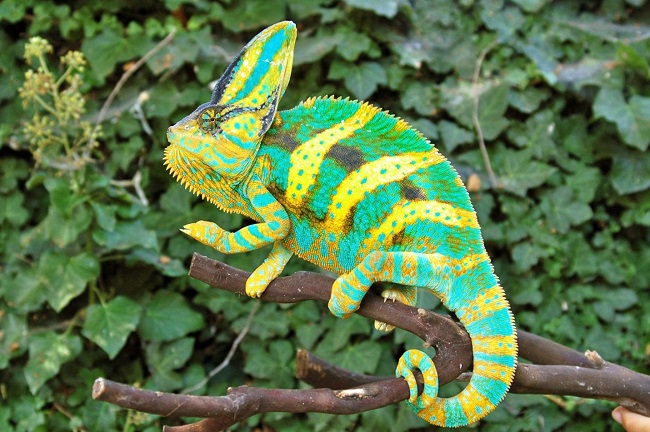Among the most iconic reptiles, Veiled Chameleons are renowned for their astounding ability to change colors. The colors of a Veiled Chameleon are not only beautiful but also serve important functions in communication, temperature regulation, and survival.
This comprehensive guide explores the wonder of Veiled Chameleon Colors, delving into how and why these captivating creatures change their vibrant hues.

Decoding Veiled Chameleon Colors
Veiled Chameleons (Chamaeleo calyptratus), also known as Yemen Chameleons, are particularly known for their broad palette of colors. The colors seen on a Veiled Chameleon can range from green, blue, yellow, orange, brown to black.
The Mechanism of Color Change
The color-changing ability of Veiled Chameleons is attributed to special cells called chromatophores located in their skin. These cells contain pigments, and by altering the arrangement of these pigments, chameleons can change their color almost instantly.
The chameleon’s nervous and hormonal system controls these cells, and the change in color is a reaction to changes in mood, light, and temperature.
Mood and Communication
Veiled Chameleons use their color-changing ability as a form of communication. For instance, male chameleons will display bright, bold colors when asserting dominance or vying for a mate’s attention.
On the other hand, submissive males or non-receptive females may display muted, darker colors. Stress or fear can also trigger color changes.
Temperature and Light
Veiled Chameleons can regulate their body temperature through their color. In cooler temperatures, a chameleon may darken its color to absorb more heat, while in warmer conditions, it may turn lighter to reflect heat.
Moreover, changes in light can trigger color changes. For example, they might display different colors at dawn or dusk.
Health Indicator
The color of a Veiled Chameleon can also indicate its health. Vibrant colors usually signify good health, while dull, dark, or unusual color patterns may signal illness or distress.
Unveiling the Veiled Chameleon’s Color Palette
While the natural color of Veiled Chameleons is primarily green, the range of colors they can display is quite diverse.
Green
Green is the most common color for a Veiled Chameleon. It provides excellent camouflage among leaves and branches, providing them protection from predators.
Blue and Yellow
Under the right conditions, especially during courtship displays or confrontations, males can exhibit beautiful shades of blue and yellow along with their green color.
Brown and Black
Chameleons may turn brown or black due to stress, illness, or to absorb more heat. Consistently dark colors could indicate a health problem, and owners should consult a vet.
The Lifespan Color Changes in Veiled Chameleons
As Veiled Chameleons grow and mature, their color pattern also evolves.
Baby Veiled Chameleons
Baby Veiled Chameleons are generally a uniform pale green or gray, helping them blend in with their leafy environments and avoid predators.
Juvenile Veiled Chameleons
As the chameleon matures into a juvenile, distinct markings start to appear. Males often begin to display more variety of colors, including blue, yellow, and brown spots, stripes, or bands.
Adult Veiled Chameleons
Adult males are the most colorful, often sporting vibrant green with patterns of blue, yellow, and brown.
Females, on the other hand, may have less variety in their color patterns and usually display shades of green with white, blue, or yellow markings.
During breeding periods, female Veiled Chameleons may exhibit dramatic color changes to signal their reproductive status.
Conclusion
The world of Veiled Chameleon Colors is a remarkable blend of biology, communication, and survival strategy. These incredible creatures use their colors not only to communicate and regulate their body temperature but also to express their health status.
Recognizing the reasons behind the color changes can help chameleon owners better understand and care for their fascinating pets.
























